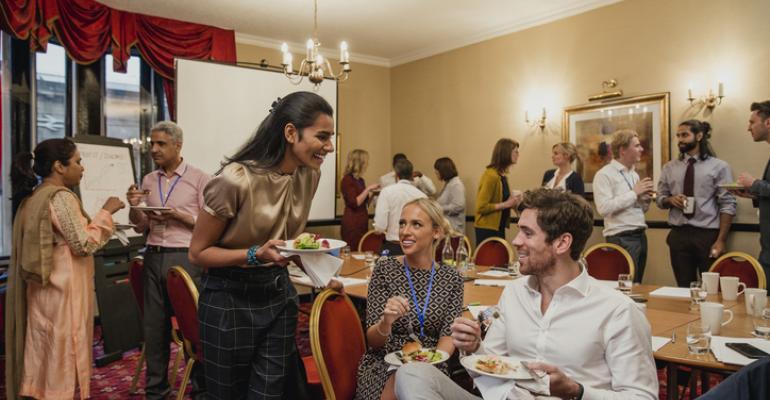While increasingly robust compliance protocols are the bane of a medical-event planner's work life, all that data going to the U.S. Centers for Medicare & Medicaid Services is a rich vein that's starting to return dividends to the life-sciences industry.
Most recently, compliance software firm AHM released a white paper titled HCP Promotional Engagements: Trends and Opportunities for the Life Sciences Industry. In the paper, the AHM authors—Frank Castora, senior director, global solutions management,and Susan Hill, senior vice president, global products & solutions—apply insight to the past three years of data supplied by life sciences companies, which appears on the Open Payments website. They also deliver analysis of the U.S. promotional engagement metrics from 10 life-sciences firms between 2012 and 2017.
The authors' goal was to identify trends that can help companies target behaviors and enhance engagement among prescribing healthcare professionals. Here's what they found.
Face-to-Face Events Dip Even as Costs Rise Slowly
The use of in-person, off-site gatherings aimed at HCPs has diminished notably in the past five years thanks to tele- and virtual programs gaining momentum; in fact, the past year alone saw venue-based events decrease from 55 percent of the total number of HCP promotional programs conducted to 45 percent. Teleprograms rose from seven percent to 11 percent of the total, while virtual programs rose from eight percent to 15 percent in a year. Office-based promotional programs remained flat at 29 percent.
While increased regulation and cost-saving initiatives are the likely causes of fewer venue-based events, HCPs find them as appealing as ever. Average attendance at venue-based programs has remained steady at 11.5 for two consecutive years, and the average has been above 10 since 2014. Oncology had the strongest showing for venue-based events (67 percent of all programs conducted in that field), while the pulmonary/respiratory field used venue-based programs just 25 percent of the time.
Surprisingly, the average cost per attendee at venue-based programs in 2017 was only minimally higher ($389) than it was in 2012 ($373), in spite of the robust hotel and travel markets over the past few years. What's more, the authors conclude that "programs featuring national experts/key opinion leaders [as speakers] indicate better value" for life-sciences companies. The evidence: Average cost for venue-based programs using nationally accredited speakers actually fell from $5,922 to $5,617 between 2012 and 2017. Average cost per program for the speakers themselves rose, but only from $3,160 to $3,289 over five years. On the other hand, average total speaker expense per program fell from $716 to $512, while average food and beverage expense per program fell from $1,285 to $1,040. The latter two trends indicate a stronger focus by planners on cost containment in part to account for meal caps, but also to have more money for solid quality of content and to fund slightly higher attendance.
Changes in lead times have clear impact on HCP attendance at venue-based events, which makes sense given the logistics required. Here’s how lead times correspond with average attendance:
• less than one week: 7.8 HCPs
• one to two weeks: 9.2 HCPs
• two to three weeks: 10.1 HCPs
• three weeks or more: 12 HCPs
Interestingly, the minimal impact on attendance when there's 14 to 21 days to promote a venue-based promotional program versus when there's only 7 to 14 days suggests that companies presented with a timely opportunity can still gain a favorable return even if they have less than two weeks to promote the event to HCPs.
With tele- and virtual events, there's an even more striking short-term phenomenon: Having just one week of promotion actually draws slightly higher HCP attendance than events with two weeks of lead time. The authors note that "HCPs behave in a similar way to online consumers of other products and services" who respond well to immediacy. The CV/metabolics, immunology/infectious diseases, and oncology fields each use tele- and virtual events for less than three percent of all programs, while the pulmonary/respiratory field use tele- and virtual events most often (33 percent of programs).
The full AHM white paper can be found through this link.
More Data Analysis Coming Over the Next Five Years
AHM's analysis of the past three years of Open Payments data represents only the beginning of such efforts. Earlier in 2018, the Centers for Medicare and Medicaid Services (CMS) awarded Bethesda, Md.-based Econometrica Inc. a five-year contract to provide research and analytical services for the Open Payments program. Econometrica provides analysis, modeling, and economic evaluations for clients in several public and private sectors. In addition to this latest agreement with CMS, Econometrica has contracts with the Department of Energy, the Department of Homeland Security, the Department of Housing, NASA, and the Transportation Security Administration.
Econometrica's contract with CMS is for $13.3 million over five years. Of this amount, 19.1 percent ($2.54 million) must be used by September 2019. The information collected will allow CMS to provide the U.S. Congress with detailed reports at different intervals, and perhaps spur changes to the Open Payments public interface. As a result, medical-device and other life-sciences companies should ensure their year-over-year data collection and reporting protocols are consistent.
—
A Pharma Snapshot from Another Research and Trends Report
In its seventh annual version of CWT Meetings & Events Future Trends Report, Carlson Wagonlit Travel recently made the following top-line observation about the pharma-events sector: "Increasing regulation on transparency is impacting budgets, but the cyclical nature of the global industry means that some companies—especially those with new product launches—are investing in their meetings and events programs, while those with products coming off patent are looking to make savings of up to 30 percent." The AHM white paper notes a similar trend as it relates to venue-based promotional programs aimed at HCPs: Such events are fewer among companies whose product pipelines are less robust at present.
To read the entire CWT report, which focuses on the overall meeting, convention, and trade show industry, visit https://www.cwt-meetings-events.com/2019metrends/.





